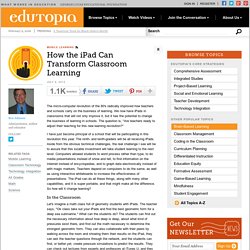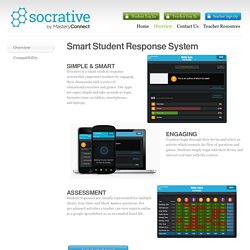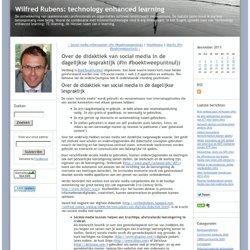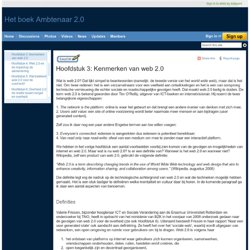

BYOD in het onderwijs. 7 Tips From Effective Teachers Who Use Technology. The Current State Of Technology In K-12 2.52K Views 0 Likes What is the next device most students will soon purchase? How many schools have a digital strategy? Find out in the current state of technology in K-12. How Online Education Has Changed In 10 Years 9.73K Views 0 Likes We all know that education, specifically online education, has come a long way in the last few years.
How the iPad Can Transform Classroom Learning. The micro-computer revolution of the 80's radically improved how teachers and schools carry on the business of learning.

We now have iPads in classrooms that will not only improve it, but it has the potential to change the business of learning in schools. The question is, "Are teachers ready to adjust their teaching for this new learning revolution? " I have just become principal of a school that will be participating in this revolution this year.
Onderwijs-door-de-eeuwen-heen2 - home. Masterclass Flipping the Classroom ? Droog's. Afgelopen dinsdag, 29 januari, heb ik kennis mogen maken met Aaron Sams en Jon Bergmann, de grondleggers van het Flipping the Classroom model.

En wat ik daar vooral geleerd heb is dat Aaron en Jon twee zeer gemotiveerde, bevlogen en excellente docenten zijn. Zij zijn zo bij hun leerlingen betrokken dat zij een techniek hebben ontwikkeld om al hun leerlingen beter te bereiken. De titel van het boek dat zij hierover hebben geschreven is niet voor niets ‘Flip Your Classroom, Reach Every Student in Every Class Every Day‘. Wat is Flipping the Classroom en Flipped Mastery? De door hen ontwikkelde techniek is zo veel meer dan wat in eerste instantie vaak gedacht wordt als je slechts de titel ervan hoort en een korte beschrijving.
Waar het echt om gaat is: ‘What is the best use of your face-to-face class time? A week of student electrodermal activity. Mediawijsheid – leerkrachten. Deze pagina is een (steeds veranderend) lijstje van bronnen en lesmaterialen rond mediawijsheid en onderwijs. Handboek mediawijsheid Een handboek gemaakt door Stichting Mijn Kind Online. Het geeft een goede kijk hoe we mediawijsheid kunnen benaderen en aanpakken op school. Meer info op de website van Mijn Kind Online en een rechtstreekse weblink naar het Handboek Mediawijsheid .
Lesmaterialen Op zoek naar mezelf in de 21ste eeuw Een project over digitale identiteit en privacy voor jongeren van het secundair onderwijs. 3 volledig uitgewerkte activiteiten geven je de kans als leerkracht om het gesprek met je leerlingen over sociale media gefundeerd aan te gaan. meer info op www.opzoeknaarmezelf.be Tips rond privacy www.clicksafe.be Initiatief van childfocus om aan voorlichting te doen rond internetgebruik bij kinderen. www.ikbeslis.be Een website van de Belgische Privacycommissie voor kinderen, jongeren, ouders, leerkracht over wat kan en wat niet kan! Mediaopvoeding Facebook for educators medialessen. How It Works. Socrative is a smart student response system that empowers teachers by engaging their classrooms with a series of educational exercises and games.

Our apps are super simple and take seconds to login. Socrative runs on tablets, smartphones, and laptops. Teachers login through their device and select an activity which controls the flow of questions and games. Students simply login with their device and interact real time with the content. Student responses are visually represented for multiple choice, true/false and Short Answer questions. Using Diigo in the Classroom - Student Learning with Diigo. Diigo is a powerful information capturing, storing, recalling and sharing tool.

Here are just a few of the possibilities with Diigo: Save important websites and access them on any computer.Categorize websites by titles, notes, keyword tags, lists and groups.Search through bookmarks to quickly find desired information.Save a screenshot of a website and see how it has changed over time.Annotate websites with highlighting or virtual "sticky notes. "View any annotations made by others on any website visited.Share websites with groups or the entire Diigo social network.Comment on the bookmarks of others or solicit comments to your shared bookmarks. To learn more about how Diigo can be used as as information management tool, visit these pages: Over de didaktiek van social media in de dagelijkse lespraktijk (#in #boektweepuntnul)) Vandaag is BoekTweePuntNul uitgekomen.

Een boek waarin lezers kort,maar helder geïnformeerd worden over 125 social media + web 2.0 applicaties en webtools. Ten behoeve van de onderwijsuitgave heb ik onderstaande inleiding geschreven. De naam "sociale media" wordt gebruikt als verzamelnaam voor internetapplicaties die een aantal kenmerken met elkaar gemeen hebben: Hoofdstuk 3: Kenmerken van web 2.0 - Het boek Ambtenaar 2.0. Wat is web 2.0?

Dat lijkt simpel te beantwoorden (namelijk: de tweede versie van het world wide web ), maar dat is het niet. Om twee redenen: het is een verzamelnaam voor een veelheid aan ontwikkelingen en het is een van oorsprong technische vernieuwing die echter sociale en maatschappelijke gevolgen heeft. Dat maakt web 2.0 lastig te duiden. De term web 2.0 is bekend geworden door Tim O’Reilly, uitgever van ICT-boeken en internetvisionair. Hij noemt de twee belangrijkste eigenschappen: 1. Zelf zou ik daar nog een paar andere Engelse termen aan toe willen voegen: